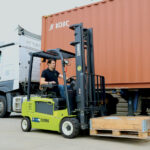Super competence: a powerful weapon!
Super competence: a powerful weapon!
In order to become disruptively competitive, a transport and logistics organisation needs to become super competent. In this article, CHARLES DEY reveals what an organisation requires to forge and deploy the weapons needed for current and future super competence.
The first and most obvious question we need to answer is this: why is organisational super competence necessary? Every transport and logistics organisation is driven by the service needs of consumers, and the levels of these needs are increasing rapidly. A few examples from the area of last-mile delivery are:
- Free shipping
- Excellent price
- Immediate visibility of the status of the delivery
- Immediate dispatch on receipt of order
- Next-day, if not same-day, delivery
Coupled with this, the post-pandemic logistics environment is characterised by sudden and unexpected supply chain bottlenecks.
If the key to competitive advantage for a transport and logistics organisation is customer satisfaction, the only way to achieve and grow such competitive advantage in this rapidly changing environment is to make every individual in the end-to-end of the supply chain super competent.
Forging weaponry for the super competent organisation
Super competency in the transport and logistics industry is built on three foundations:
- Competency mapping
- Skills profile development
- Alignment of today’s competency needs with the organisation’s future scenario planning and strategy.
Competency mapping is the process of identifying the competency clusters required in each area within the particular organisation’s supply chain. For example, within the warehousing area we find that receiving, put away, inventory management, pick and pack, and dispatch are clusters of competence required.
Our experience tells us that each defined competence is required at different levels, depending on the function being carried out by each member of the team in a particular area. In our warehousing example, a supervisor will need to be competent in receiving at one level, while the receiving clerk will need to be competent at another. Competency mapping integrates all the competencies within each function, as well as the different levels of competency.
The competency map for each function is compiled from a number of different sources: job descriptions, personal interviews with people carrying out different functions, group workshops, and so on.
Having determined the competency needs of a functional area, the next step is to select the competencies required for each function in that area. What competencies, for instance, will the warehouse supervisor require (and at which levels)? What competencies do the picker and packer require (and at which levels)? The answers to these questions and more will enable us to compile skills profiles for each of the functions for that area. This method is used to compile competency maps and skills profiles of every functional area of the organisation.
The competency maps and skills profiles which have been developed using this methodology are a powerful tool for describing the attributes of each person required to carry out each specific function within the organisation.
It is important to appreciate that, at this stage, what has been achieved is a still photo of the competency needs of the present organisation: once a new operating system, next-generation equipment, or even a new customer comes on board, at least some of these competency maps and skills profiles will change, even if only subtly. This brings us to the point at which the competency requirements of the present functional areas of the organisation need to be aligned with those of the organisation’s future scenario planning and strategy.
Deploying super competency weaponry
What we have now is a powerful weapon which objectively defines the competencies required of each team member in every area of a logistic and transport organisation’s activities.
If super competency means that every member of each team is equipped with the competencies required to carry out their functions in terms of the skills profile defined for that function, then the question we need to ask is: “How do we assess the extent to which each team member displays each of the competencies required?” Once we know this, we can develop the tools needed to address the competency gaps which we measure.
Keep in mind that, by aligning the organisation’s present competency needs with its future scenario planning and strategy, we also have the weapon which will enable us to develop our people for the organisation’s sustained success.
The tools we need to develop to assess these competency gaps and to address them once measured will be revealed in future articles.
Do you feel like adding to the discussion around these ideas? Please visit www.charlesrdey.blogspot.com to join the debate.
Published by
Charles Dey
focusmagsa




